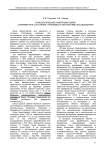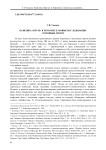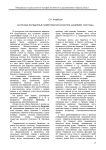Археология. Рубрика в журнале - Материалы по археологии и истории античного и средневекового Причерноморья

"Казарма" в портовом районе города: основные итоги исследования (взгляд из Херсонеса)
Статья научная
В статье представлены результаты археологических исследований комплекса построек, известных в историографии как «Казарма» в Портовом районе Херсонеса, проведенных совместной экспедицией Харьковского государственного университета и Национального заповедника «Херсонес Таврический» в 1993-1998 гг. В ходе работ было завершено изучение всех основных составных частей этого архитектурно-археологического комплекса: Центр «Казармы», «Галерея», помещений 35, 36 (А, Б, В, К), 38, 61, 63 и др. Была осуществлена его графическая фиксация. Также в ходе работ была прослежена стратиграфия напластований культурного слоя. Получен значительный массовый археологический материал. Результаты его изучения позволяют проследить основные этапы строительной истории и реконструировать внешний вид «Казармы».
Бесплатно

"Княжеские" находки и центры власти гуннского времени на периферии Понтийской степи
Статья научная
Рассматривается география распространения т.н. «княжеских» находок, относящихся к последней трети IV - первой половине V вв. на северной и западной периферии причерноморских степей, занятых в то время гуннами. Данные находки связаны с оседлым населением, поскольку располагаются на территории, где фиксируются археологические культуры оседлых варваров. География их распространения позволяет выявить центры власти, варварские «королевства» на окраине гуннской степи. Вне всякого сомнения, эти центры власти находились в зоне военно-политического доминирования гуннов. По отношению к зависимым от них оседлым варварам, гунны применяли две формы управления. В первом случае власть осуществлялась через посредство назначенного гуннами наместника. Вторая форма управления предполагала существование вассальных варварских политических образований, где гунны использовали власть местной оседлой аристократии.
Бесплатно

Статья научная
Деятельность выдающегося российского историка И.Е. Забелина как археолога оценивается в истории науки неоднозначно. Неизвестный ранее источник - рукописная инструкция И.Е. Забелина по раскопкам курганов Северного Причерноморья - позволяет расставить новые акценты в трактовке его полевой методики. И.Е. Забелин рекомендовал раскапывать курганы полностью, и только недостаток средств и времени заставляли его копать траншеями. Обосновывая необходимость оставлять находки in situ и отмечать их расположение, он делал верные рекомендации по обнаружению и вскрытию основного погребения, требовал использовать компас, обязательно чертить план и разрезы кургана, вести полевой дневник, фиксируя все детали, положение скелетов человека, коня, инвентаря. Инструкция представляет собой обобщение собственного опыта И.Е. Забелина по раскопкам курганов Скифии и некрополей античных городов; он сам следовал предложенным правилам, на что указывают другие архивные и печатные материалы. В дальнейшем целесообразно привлекать архивные материалы для анализа вклада И.Е. Забелина - внимательного и ответственного полевого исследователя - в методику археологических исследований.
Бесплатно

Celto-Scythians and celticization in Ukraine and the North Pontic region
Статья научная
The article provides an overview of the available linguistic, numismatic and archaeological evidence pertaining to the expansion of the La Tene culture into the area of modern Ukraine and the North Pontic region from the 3rd century BC onwards. A distinction is observed between the situation in western Ukraine where the process of Celtic migration - colonization is reflected in the archaeological evidence, and further east where the presence of Celtic “warrior bands” - mercenary groups have been identified. The testimony in ancient sources to the emergence of mixed Celto-Scythian populations in this area is also considered.
Бесплатно

Статья научная
In this paper, twelve marble “medallion” capitals of the Holy Land are collected together, stylistically analyzed, and dated for the first time. For a better understanding of their geographical distribution, the places of recovery were marked on the map. In the recent article of C. Barsanti (2017), only 40 capitals of this type were collected throughout the whole Mediterranean region, so the number of local artifacts is rather considerable. None of the local capitals was revealed in situ but only in secondary use in the Early Islamic context or scattered at the sites. In all cases, Early-Byzantine churches dated to the 5th - 6th centuries CE were located in close vicinity. The paper consistently provides them as apparent sources from which the capitals might be hypothetically generated. Stylistic analysis showed the process of order alteration: the recognizable morphological basis of the type was followed (though not strictly) in all specimens. At the same time, ancillary details might vary considerably from one capital to the other. This process implies gradual order decline moves from more complete and detailed to more laconic variations of the “medallion” type.
Бесплатно

New materials on sacrificial animals in Yanglang culture burials of the 5th - 3rd cc. BCE (China)
Статья научная
This article focuses on the analysis of the sacrificial animals remains in burials of the 5th - 3rd сс. BCE of the Yanglang Culture Wangdahu burial ground identified with the Western Rongs who lived on the Qin kingdom western borders. As a rule, Eurasia Cattle breeders placed one or two parts or livestock carcasses in ordinary burials. In contrast to them, in the Yanglang Culture in one person ordinary burial up to 30, 50 or more skulls of all major livestock species (horses, cattle, sheep and goats) could be placed. In the analysis of sacrificial animals from the Yanglang Culture burial grounds detailed description, the authors came to the conclusion that in a number of burials the composition of animal species and their ratio fully correspond to the Central Asia nomads’ herd averaged data. Apparently, the burial grounds organizers were sent real herd to the other world with the dead people or recruited animals for slaughter keeping the proportions known to them. The proportion of horses is much higher in the chariot warriors` burials which is associated with the deceased special status. As it turned out, even 1-3 years old children could have such status during burial in Wangdahu. Foals and votive weapons full set were placed in such burials. All of this suggests the chariot warrior’s high status which was established in the funeral rite. The maintenance and training of chariot horses large number, the horses and chariot warriors equipment manufacturing required the state structures participation. It is no coincidence that the number of chariots served as a state power yardstick in ancient China. All these preliminary observations and conclusions are consistent with indirect information from Chinese historical sources about the developed horse breeding among the Western Rongs, their special relationship with the Qin kingdom and possibly the early state formation existence among them.
Бесплатно

Статья научная
One of the most important finds from the richest of the Thracian hoards, the Rogozen Treasure, is the so- called Auge Phiale. Its chronological position is crucial for the dating of the Hoard and had already been a point of debates. Its decoration, which consists of a mythological scene in high relief occupying the interior of the flat bottom and a relief pattern of alternating palmettes and lotus flowers grouped around the central rosette on the outside is discussed, thus allow us not only to determine the position of the vessel among the masterpieces of the Late Classical/Early Hellenistic metalware, but also to dwell on the genesis of the main subject of the composition. Clarifying the chronological position of the phiale is also extremely important for the establishment of the date, when the Treasure was hidden.Both the analysis of the general shape, the construction and composition of the elements of the vessel, the ornamental patterns decorating its bottom and the parallels of the figural composition on the inner medallion do not allow dating earlier than 350/340 BCE. Moreover, there is strong evidence that the phiale should be dated in the chronological frames of the last quarter of the 4th - first decades of the 3rd century BCE. The shape of the vessel and the decoration of its bottom may suggest a somewhat earlier dating, whereas that of the medallion - somewhat later, within the frames of the chronological period mentioned above. Thus, it may be a further confirmation of the history of the vessel, reconstructed on the grounds of its technological examination.This is not the only vessel from the Rogozen Treasure for which a dating after 340 BCE and as late as the last quarter of the 4th/early 3rd century BCE, first decades or even the second quarter of the 3rd century BCE has been already proposed. Consequently, it provides another argument that the Treasure was buried much later than it was usually suggested before (330s BCE).
Бесплатно

Статья научная
The paper is devoted to the complex analysis of silver objects from the burial complexes of Asian Sarmatia of the 2nd century BCE - 3rd century CE, representing both typological and cultural-historical analysis of these items in combination with the study of the isotopic composition of Pb in order to try to answer questions not only about possible centers of the manufacture of objects, but also of the sources of the metal. Pb-Pb data were obtained using inductively coupled plasma multicollector mass spectrometry (MC-ICP-MS) carried out in the Laboratory of isotopic geochemistry and geochronology of the Institute of Geology of Ore Deposits, Petrography, Mineralogy, and Geochemistry RAS, Moscow.The overwhelming majority of the objects are dated within the 1st century BCE - 1st century CE time span. The stylistic features of the items indicate that their origin is associated with several production centers: 1) the workshops of the ancient cities of the North Pontic region, first of all, the Bosporan Kingdom; 2) workshops located in Asia Minor or in the Eastern Mediterranean; 3) round-bottomed goblets and some of the phalerae of horse-harness should be attributed to the products of Sarmatian craftsmen, most probably manufactured both inthe Lower Volga and in the Kuban region; 4) a neck guard of the helmet of the East Celtic type, secondary used as a breastplate of horse-harness, is undoubtedly the product of the Celtic ( Taurisci ) workshop, located in the territory of modern Slovenia.The 17 silver items demonstrate substantial heterogeneity in terms of the Pb isotopic composition. The values of 206Pb/204Pb, 207Pb/204Pb and 208Pb/204Pb ratios vary in the ranges: from 18.07 to 19.41, from 15.60 to 15.75, and from 38.3 to 40.4 respectively. The large variation (ν206/204 = 1.4%, ν207/204 = 0.2%, and ν208/204 = 1.2%) can be explained by the origin of the metal from several ore provinces located in the Black Sea region, Asia Minor and the Near East. The Pb isotopic composition of most of the items is consistent with deposits in the Black Sea region - Eastern Balkans (6 items) and Eastern Pontides (6 items). The Pb-Pb data indicates that silver also could come from the deposits of the Taurus (South-Eastern Turkey) and Zagros (Western Iran) Mountains.
Бесплатно

The cultures of the early iron age in China as a part of the Scythian world
Статья научная
Based on archaeological and written sources, the authors characterizes the two ethno cultural regions of the 9th - 3rd centuries BCE that developed in the east of the Scythian world - in Xinjiang and North China. In the 9th - 8th centuries BCE there, in local cultures of transitional appearance, burial complexes with “Scythian triad” individual elements in the Animal style in a horse bridle are recorded. It is obvious that both of these areas were the early Scythian cultures formation centers like the center in Tyva. At the same time, according to all sources, the Animal style was brought to the China territory from Mongolia. Due to natural factors, in these areas up to the 2nd century BCE Scythian cultures developed almost in isolation from each other in contact with the adjacent Kazakhstan, Southern Siberia and Mongolia regions. In the second half of the 4th century BCE the northern part of Xinjiang (including the Tien Shan) get closed culturally with Pazyryk culture of Altai, and then to the Sakas and Wusuns of Kazakhstan. At this time the North China cultures were in close contact with South Siberia population. At the same time, some Scythian-like features were preserved in them until 3rd - 2nd centuries BCE, even after the Han and Xiongnu empires formation at the end of the 3rd century BCE.
Бесплатно

Статья научная
The current migration routes may represent an excellent record while studying nomadic populations in the past. And although we can only extrapolate the current situation or the results of comparative studies to the past without equating them, migration routes may be used as research contexts of high reliability. The slopes of Sabalan Mountain in the northwest of Iran is among principal summer pastures used by the herders of the Shahseven tribes. Here, the vast majority of Iron Age sites are cemeteries not associated with settlements, so in the past the area was used by the nomads for their summer camps. During the research of migration routes of the modern-day Shahseven leading to the summer pastures, multiple Iron Age cemeteries, as well as fortified settlements and campsites, were discovered. In large-scale field investigations, archaeological sites were thoroughly surveyed to locate them in relation to current migration routes and to verify possible relationship between them. In the research area, sites were studied both by number and by categories, and the sought-for relationship has been established. It is obvious that the sites are concentrated along migration routes. Both on the mountain slopes and adjacent plains, traces of ten pathways of primary and secondary importance were recovered, and Iron Age sites are found throughout along them. Hence, some modern migration routes appeared to have been in use during the Iron Age, although the traditional ancient pathways may not have been entirely the same as modern ones.
Бесплатно

Two Pontos castles in Vezirk"opr"u, reg. Samsun: B"uy"ukkale (Sagylion) and K"uc"ukkale
Статья научная
Vezirköprü, the district of Samsun, is an area of a continuous sedentism for millennia, from the Chalcolithic and Early Bronze Age until the present, due to its location at an important crossroads, with wide plains and numerous streams all around, and a landscape suitable for settled life. Being a village named Phazemon, in Strabo’s words, the site gained the identity of a city with the Roman domination in the region and took the name Neoklaudiopolis (Neapolis). The city has witnessed many wars and showed that it had an important strategic position. Mithridates VI Eupator, King of Pontus, was the biggest enemy of Roman domination in Anatolia back then. In Pontus’s coastal parts, castles have already been known, while those in the inner parts of the region have not been adequately researched. Büyükkale and Küçükkale, which are the scope of the paper, are among the latter. Both castles display many things of traditional Mithridatic fortification, with castle walls, rock tunnels, stairs, and tombs. The one in Büyükkale is identified with Sagylion of old written accounts. The castles under study have not yet been published elsewhere, and the paper is expected to contribute to the illumination of the construction activity of the Pontic Kingdom and the Hellenistic Period in Vezirköprü.
Бесплатно

«Савроматское» захоронение с У-образными псалиями в верховьях р. Эмба
Статья научная
Публикуются материалы из центрального погребения (№ 3) в кургане 1 могильника Жагабулак I, исследованного в 2021 г. археологической экспедицией Института археологии им. А.Х. Маргулана и Актюбинского областного историко-краеведческого музея. Могильник расположен на малоисследованной территории между Южным Приуральем, плато Устюрт и Приаральем, и это придаёт материалам из кургана 1 ярко выраженный промежуточный, переходный облик, в котором запечатлелись особенности не только указанного пограничья, но и более отдалённых западных и восточных регионов. В этом отношении показательна уздечка с железными деталями из погребения 3. В её состав входили У-образные псалии, типологически соотносимые со специфическими бронзовыми У-образными псалиями, бытовавшими только в раннескифское время (VII - начало VI в. до н.э.) на ограниченной территории Алтая и Тувы. Удила имели петлевидные окончания, характерные для западной скифской узды, но не встречавшиеся в VI-III вв. до н.э. на востоке - на Алтае, в Южной Сибири, Синьцзяне и в других областях. Кроме того, удила и псалии в погребении 3 составляли неразъёмную конструкцию, принцип которой получил наибольшее распространение в Передней Азии и был известен с раннескифского времени в Приаралье. У- образные псалии из погребения 3 не являются переиспользованной деталью раннескифского времени. Они созданы в данном регионе не позднее середины VI в. до н.э. по ещё имевшим тогда хождение У-видным образцам восточного происхождения и использованы в связке с западными удилами. Наличие уздечки с У- образными псалиями указывает, вероятно, и на более ранние даты бытования колчанных наборов стрел, подобных найденным в погребении 3, в пределах, предположительно, середины VI в. до н.э.
Бесплатно

Античное поселение Казантип Восточный и сейсмотектоника Крымского Приазовья
Статья научная
В 2021 г. выполнены археосейсмологические и геолого-геофизические исследования городища Казантип Восточный II и его окрестностей. В строительных остатках и естественном окружении городища выявлены и изучены как сейсмически наведённые, так и сейсмотектонические деформации, оставленные очагом сильного землетрясения. Сейсмический очаг вышел на поверхность в пределах городища в виде сейсмотектонического разрыва и сместил одну из его стен. Величина интенсивности сейсмических воздействий была не менее Io = 9 баллов по шкале МSК-64. Можно предположить, что на памятнике зафиксированы признаки выхода очага сильного землетрясения середины I в. до н. э. (63 г. до н. э.?).
Бесплатно

Археологические данные к локализации крепости Билистан
Статья научная
В статье рассматривается вопрос локализации крепости Билистан, которую по данным авторитетного арабского историка Ибн А’сама ал-Куфи (ум. 926) осаждали арабские войска во главе с наместником Арминийи Марваном ибн Мухаммадом в 738 г., в период завоевательных кампаний на Восточном Кавказе, и в которой укрывался царь лакзов Арбис ибн Басбас. Согласно информации, приведённой в «Китаб ал-футух» Ибн А’сама ал-Куфи, это укреплённое поселение располагалось в«стране лакзов» в среднем течении реки Самур. В 2019 г. одним из авторов этой статьи на основе лингво-этимологического и топонимического анализа была предложена гипотеза, согласно которой этот исторически засвидетельствованный пункт мог находиться на среднем течении р. Самур, в зоне расположения современного сел. Куйсун. Выявленное здесь в 2023 г. городище с укреплённой цитаделью, а также полученный там керамический комплекс позволяют датировать этот археологический объект VI-VIII вв. Существуют веские аргументы для локализации крепости Билистан на месте городища Куйсун.
Бесплатно

Археологические памятники бойки: современное состояние, проблемы и перспективы исследования
Статья
Бесплатно

Археологические работы Таманской экспедиции ГАИМК
Статья научная
Таманская экспедиция Государственной Академии истории материальной культуры (ГАИМК) была создана в 1930 г. Во главе её встал замечательный археолог А.А. Миллер. Экспедиция была нацелена на систематическое изучение памятников древности, расположенных на Таманском полуострове, но исследования здесь продолжались всего два года. За это время удалось создать археологическую карту Таманского полуострова. Главным объектом исследований было выбрано городище Тмутаракань/Гермонасса. Небольшие раскопки были предприняты также в Фанагории, на поселении у Суворовской крепости и в Патрее. В Патрее была открыта винодельня римского времени. Основная причина недолгой истории экспедиции заключается в том, что руководство ГАИМК игнорировало интересы московских археологов и не шло ни на какие компромиссы. На этой почве разразился серьёзный конфликт, в результате которого перспективный научный проект был закрыт, а некоторые его участники подверглись политическим репрессиям.
Бесплатно

Археосфера земли (археологическая концепция археосферы)
Статья научная
Специализированное видение планетной «сферы древнего» отрефлексировано, сформулировано и соотнесено с концептами внеземной археосферы, антропогенно изменённой тверди, ископаемой реальности, археологической записи, всеобщности памятников. Форма, характер, сущность и функция археосферы раскрыты изучением её компонентного состава ввиду процессов культурогенеза и археогенеза во всеохватности взаимоотношений археологических универсалий. Новая модель рассматривает археосферу как глобальную систему упокоенных и возвращаемых, связно-иерархически универсализированных объектов двойственного генезиса; это системное запечатление поведенческих и неповеденческих преобразующих процессов циклического характера - депонирования и реактивации сложного многообразия феноменов культурно-природной синергии. Прогнозируется обсуждение структуры и периодизации археосферы, её места среди земных систем. Дисциплины же и субдисциплины археологической науки заняты созданием археосферной концепции реальности.
Бесплатно

Базилика «Крузе» в Херсонесе: новые исследования. Основные итоги
Статья научная
Раскопки последних лет храмового комплекса базилики «Крузе» в Северо-восточном районе Херсонеса позволяют (на основе археологических и нумизматических материалов) обоснованно утверждать, что его возведение произошло в эпоху Юстиниана Великого. Планировочная схема храма (с пристроенными с востока помещениями) выглядит еще более оригинально, чем это представлялось ранее.
Бесплатно

Бендерская крепость в XVI в. по данным археологических исследований
Статья научная
В феврале-марте 2019 г. Днестровская археологическая экспедиция провела исследования нижнего яруса Юго-Восточной башни цитадели Бендерской крепости. На глубине 3,35 м от уровня входа расчищен пол из каменной крошки с известью. Его сооружение связано с первым стратиграфическим горизонтом башни (1538 г.). Второй горизонт представлен заполнением нижнего яруса башни в виде светло-жёлтого лессовидного суглинка, мощностью 1,6-1,7 м, в котором были найдены фрагменты гончарной керамики XVI в., металлические изделия и кости животных. Археологические исследования 2019 г. подтвердили версию о том, что первые каменные укрепления были сооружены здесь именно турками, и не ранее конца 1530-х гг. В ходе исследований второго стратиграфического горизонта установлено, что он сформировался в процессе реконструкции и расширения крепости в 1584 г. В начале этого года по приказу турецкого султана молдавский господарь Пётр Хромой приступил к реконструкции полуразрушенных польско-казацкими набегами укреплений. За несколько месяцев были сооружены внутренний ров и Нижняя крепость. Суглинок из заполнения рва был использован для засыпки нижнего яруса Юго-Восточной, и вероятно, других башен цитадели, чтобы укрепить их против усилившейся осадной артиллерии и подкопов. В материалах этого горизонта отразились новые тенденции в фортификационном искусстве второй половины XVI в. на территории Северного Причерноморья и соседних регионов.
Бесплатно


